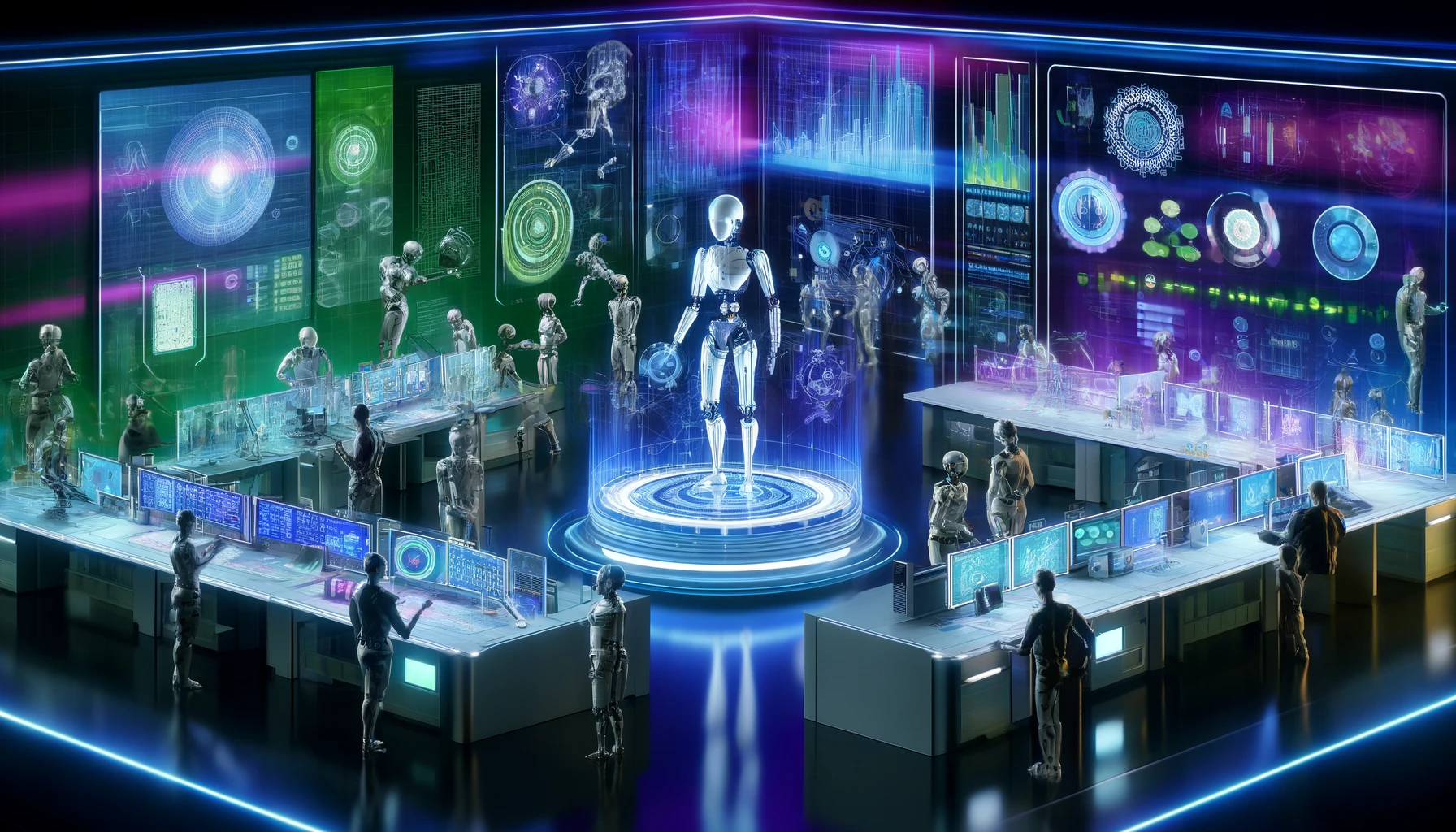Picture a digital brain that can think, learn, and act on its own. That’s the world of AI agent architectures. These frameworks serve as the blueprints for how artificial intelligence perceives its surroundings, processes information, and takes meaningful action. Unlike traditional software that follows rigid rules, AI agents adapt and evolve, much like living organisms responding to changes in their environment.
The field of agent architectures has made significant progress since its early days. According to Taskade’s research, the modern concept emerged from a groundbreaking paper on Task-Driven Autonomous Agents published in early 2023. In just over a year, this innovation has transformed from an experimental concept into a powerful tool reshaping our understanding of artificial intelligence.
Today’s AI agents are incredibly versatile, capable of handling everything from simple chatbot interactions to complex decision-making in autonomous vehicles. They learn and adapt, modifying their behavior based on experience and changing circumstances.
This exploration of agent architectures will uncover how these digital minds are built, examine the various types of architectures that give them their capabilities, and see how they’re applied across different industries. From basic reflex agents that respond to immediate stimuli to sophisticated learning agents that evolve over time, we’ll discover the building blocks that make autonomous AI possible.
Dive into the intricate world where code meets cognition and discover how these architectural frameworks are shaping the future of artificial intelligence.
Overview of Agent Architectures
The world of artificial intelligence is evolving in how machines make decisions. At the heart of this transformation are agent architectures—the frameworks that determine how AI systems perceive, reason, and act in their environments. These architectures serve as cognitive blueprints enabling machines to operate with increasing autonomy.
Reactive agents, the simplest of the architectures, operate like well-trained reflexes. They follow a straightforward ‘if-this-then-that’ approach, making them incredibly fast at responding to environmental changes. According to researchers at GeeksforGeeks, reactive agents excel in situations requiring immediate responses, much like how a thermostat adjusts temperature without needing to understand the concept of comfort.
Deliberative agents, in contrast, take a more thoughtful approach. These sophisticated systems maintain internal models of their world and carefully plan their actions. Think of them as strategic players in a chess game, considering multiple moves ahead before making a decision. They are particularly valuable in complex scenarios where long-term planning and reasoning are essential.
Hybrid architectures represent an elegant marriage between reactive and deliberative approaches. By combining quick reflexes with strategic thinking, hybrid agents can handle both immediate challenges and complex long-term goals. This architecture type has gained significant traction in robotics and autonomous vehicles, where split-second reactions must coexist with careful navigation planning.
Learning agents bring another dimension to AI capabilities through their ability to improve over time. Rather than relying solely on pre-programmed responses, these systems adapt their behavior based on experience. Each interaction becomes a learning opportunity, allowing the agent to refine its decision-making process and improve its performance.
Utility-based agents add a sophisticated layer of decision-making by evaluating the desirability of different outcomes. Instead of simply achieving goals, these agents consider the relative value of various actions and choose the one that maximizes overall benefit. This approach is particularly valuable in scenarios where multiple competing objectives need to be balanced, such as resource allocation or financial trading systems.
The choice of architecture ultimately depends on the specific requirements of your application. While reactive agents might be perfect for simple, speed-critical tasks, more complex scenarios might demand the sophisticated reasoning of deliberative or hybrid approaches. Understanding these architectural patterns is crucial for developing AI systems that can effectively navigate our increasingly complex world.
Reactive Architectures and Their Adaptability
Reactive architectures represent a streamlined approach to system design, responding instantly to environmental changes without the complexity of maintaining internal models. These systems excel in scenarios requiring split-second decisions, making them particularly valuable in fast-paced, dynamic environments where every millisecond counts.
The beauty of reactive architectures lies in their inherent simplicity. By directly coupling inputs to outputs through predefined rules, these systems can process and react to stimuli with remarkable speed. Consider a basic reactive system where data automatically changes when related data changes – if variable b or c updates, variable a adjusts immediately through a notification system.
One of the most compelling aspects of reactive architectures is their effectiveness in real-world applications. In dynamic environments such as automated trading systems or real-time gaming engines, these architectures shine by delivering rapid responses to changing market conditions or player actions. Their ability to process inputs and generate outputs without complex internal deliberation makes them ideal for scenarios where speed takes precedence.
However, reactive architectures face notable limitations in their adaptability. Since they operate based on predefined rules and responses, they struggle to handle novel situations that fall outside their programmed parameters. Unlike systems with learning capabilities, reactive architectures cannot evolve their behavior patterns or generate new responses based on experience.
The trade-off between speed and adaptability becomes particularly evident in complex environments. While reactive systems excel at handling known scenarios with lightning-fast responses, they may falter when confronted with unexpected situations that require more nuanced decision-making. This inflexibility can pose challenges in environments where conditions frequently change in unpredictable ways.
Agents without environment models must have sufficient information available from local environment. If decisions are based on local environment, how does it take into account non-local information? It has a ‘short-term’ view.
Limitations of Reactive Agents Research Paper
Deliberative Architectures: Planning and Reasoning
Deliberative architectures represent a sophisticated approach to artificial intelligence that mirrors how humans carefully think through decisions. Like a chess grandmaster plotting several moves ahead, these AI systems maintain detailed internal models of their environment, allowing them to reason about potential outcomes before taking action.
Deliberative architectures operate through a methodical process of sensing, modeling, planning, and acting. They first observe their environment, update their internal world model, generate potential plans, evaluate likely outcomes, and finally execute their chosen action. This approach shines in scenarios requiring strategic depth, such as an autonomous vehicle plotting an optimal route while considering traffic patterns, weather conditions, and passenger preferences.
The true power of deliberative architectures lies in their ability to engage in long-term planning. Much like a corporate strategist analyzing market trends to make informed business decisions, these systems can reason about complex chains of actions and their consequences. They excel in structured environments where careful consideration outweighs rapid response, from automated factory scheduling to sophisticated game-playing AI.
However, deliberative architectures face important limitations. Their reliance on maintaining and updating detailed world models means they can struggle in highly dynamic environments where conditions change rapidly. Think of how a carefully planned chess strategy might fall apart when faced with an opponent making unexpected moves. This computational overhead makes them less suitable for scenarios requiring split-second reactions.
The effectiveness of deliberative architectures ultimately depends on the quality of their internal models. While they can masterfully handle complex planning tasks in well-defined domains, they may falter when encountering novel situations that weren’t accounted for in their world model. It’s similar to how a GPS navigation system might struggle when encountering an unexpected road closure; the system needs time to recalculate based on its updated understanding of the environment.
Hybrid Architectures: Combining Reactive and Deliberative Approaches
Balancing lightning-fast reactions with thoughtful planning is a crucial challenge in autonomous systems. Hybrid architectures offer a solution by combining reactive control for immediate responses and deliberative planning for complex decision-making.
Imagine a rescue robot in a disaster zone. Using its reactive components, it can instantly dodge falling debris or navigate sudden obstacles. Meanwhile, its deliberative systems plot the optimal path to reach survivors and coordinate with other rescue teams. This integration of quick reflexes and strategic thinking exemplifies the value of hybrid architectures.
A prominent example is the AuRA (Autonomous Robot Architecture) system developed by Arkin in 1986. AuRA combines a traditional AI planner for high-level strategy with reactive motor schemas for direct environmental responses. This dual approach allows robots to maintain both moment-to-moment safety and progress toward long-term goals.
Another compelling implementation is the Atlantis architecture used in Mars rover exploration. Its three-tiered system includes a reactive controller for immediate actions, a sequencer for managing activities, and a deliberator for complex planning. This structure enables the rover to respond swiftly to hazards while methodically exploring and mapping the Martian terrain.
The key benefit of hybrid architectures lies in their adaptability. The reactive layer provides robustness in dynamic, unpredictable situations where split-second decisions are crucial. The deliberative layer contributes strategic oversight and optimization, allowing the system to learn from experience and improve over time.
In practice, hybrid architectures have proven successful across diverse applications—from manufacturing robots that combine precise movements with strategic task planning, to household robots that avoid obstacles and efficiently map out cleaning routes. This versatility makes them particularly valuable as autonomous systems take on increasingly complex roles.
While implementing hybrid architectures presents challenges, such as managing the interaction between reactive and deliberative components, the benefits far outweigh the complexities. These systems show that the future of autonomous agents lies in skillfully combining quick reactions with thoughtful planning to create more capable and adaptable systems.
Case Studies: Adaptive Learning in Autonomous Agents
Autonomous agents equipped with adaptive learning capabilities represent a significant leap forward in artificial intelligence, demonstrating the ability to evolve and improve through real-world experiences. These AI systems don’t simply follow static programming; they actively learn from each interaction, gradually enhancing their performance over time.
In robotics, adaptive learning has enabled dramatic improvements in how machines navigate complex environments. For instance, research from the U.S. Army Research Laboratory demonstrated how robots using few-shot machine learning could dynamically recognize unfamiliar environmental conditions and adapt their behavior in real-time, significantly improving their survivability in challenging situations.
| Method | Description | Advantages | Challenges |
|---|---|---|---|
| Genetic Theory of Adaptation | Uses evolutionary algorithms to adapt robot behavior. | Highly adaptable to different tasks. | Computationally intensive. |
| Transfer Learning | Utilizes knowledge from one domain to improve learning in another. | Reduces training time and data requirements. | Finding relevant source domains. |
| Reinforcement Learning (RL) | Agents learn by interacting with their environment and receiving feedback. | Effective for complex tasks with clear rewards. | Requires a large number of interactions. |
| Neural Networks (NNs) | Uses layers of interconnected nodes to model complex patterns. | Highly flexible and capable of modeling nonlinear relationships. | Requires large datasets and computational power. |
| Hybrid Architectures | Combines reactive and deliberative approaches for optimal performance. | Balances immediate reactions with long-term planning. | Complex to design and implement. |
Autonomous vehicles provide another compelling example of adaptive learning in action. Modern self-driving systems continuously analyze vast amounts of sensor data to refine their decision-making capabilities. As these vehicles encounter diverse traffic scenarios, weather conditions, and road types, they build increasingly sophisticated models of how to navigate safely and efficiently. Research shows that through this iterative learning process, autonomous vehicles have achieved remarkable improvements in key metrics like object detection accuracy and reaction times.
Virtual assistants showcase how adaptive learning enables AI to become more personalized and responsive over time. These systems analyze patterns in user interactions to better understand individual preferences and communication styles. For example, they learn to recognize speech patterns more accurately, anticipate common requests, and provide increasingly relevant responses based on accumulated experience.
Adaptive learning enables AI agents to improve their performance over time by learning from experiences. Case studies show how these systems can enhance their capabilities through continuous learning and refinement.
H. J. Vishnukumar, Research on AI-powered methodology for autonomous systems
The impact of adaptive learning extends beyond individual improvements in performance. When multiple autonomous agents interact and share their learned experiences, they can collectively evolve faster and handle a broader range of scenarios more effectively. This network effect accelerates the overall advancement of autonomous systems across different applications.
Looking ahead, adaptive learning will continue to play a crucial role in developing more capable and reliable autonomous agents. As algorithms become more sophisticated and computing power increases, we can expect to see even more impressive demonstrations of machines that truly learn and grow from their experiences in the real world.
The Role of SmythOS in AI Agent Development


Modern AI development demands powerful, flexible tools that can streamline the creation and management of autonomous agents. SmythOS offers developers a comprehensive platform that transforms complex AI agent development into an intuitive, visual experience.
At the heart of SmythOS lies its visual workflow builder. This drag-and-drop interface eliminates the need for extensive coding, allowing developers to map out sophisticated AI processes with ease. When coupled with the platform’s extensive library of pre-built components, teams can rapidly prototype and deploy autonomous agents that tackle everything from data analysis to customer engagement.
SmythOS’s built-in monitoring capabilities set it apart in AI development. The platform provides real-time insights into agent performance, enabling developers to track key metrics and identify potential issues before they impact operations. This proactive approach ensures AI agents maintain peak efficiency while operating autonomously.
Logging functionality within SmythOS serves as a comprehensive audit trail for AI agent activities. As detailed in recent documentation, developers can trace data flows and decision paths, making it significantly easier to debug issues and optimize agent behavior. This transparency is crucial for maintaining reliable autonomous systems that stakeholders can trust.
Integration capabilities further enhance SmythOS’s value proposition. The platform seamlessly connects with various APIs and data sources, enabling AI agents to interact with existing tools and services. This flexibility ensures that autonomous agents can access the information and functionality they need to perform complex tasks effectively.
SmythOS transforms the complex process of Agent-Based Modeling development into an intuitive, visual experience.
Alexander De Ridder, Co-Founder and CTO of SmythOS
Perhaps most impressively, SmythOS handles resource management automatically, ensuring optimal performance as workloads fluctuate. The platform’s sophisticated load balancing and auto-scaling capabilities mean developers can focus on enhancing agent functionality rather than wrestling with infrastructure concerns.
Conclusion: Future Directions in Agent Architectures


Exploring digital networks and AI advancements. – Via nextplatform.com
The future of AI agent architectures stands at a fascinating crossroads of innovation and practical application. Agent architectures are evolving rapidly, with a clear trajectory toward more sophisticated and adaptable systems. These advancements will fundamentally reshape how AI agents interact with humans and handle increasingly complex tasks.
Enhanced adaptability emerges as a cornerstone of future agent development. Tomorrow’s AI agents will need to seamlessly adjust their behavior based on context, user preferences, and changing environmental conditions. This flexibility will be crucial for creating more reliable and trustworthy AI systems that can operate effectively across diverse scenarios.
Human interaction capabilities will see significant refinement, moving beyond simple command-response patterns toward more nuanced and context-aware exchanges. Recent research in AI agent implementations demonstrates a growing focus on achieving complex goals through enhanced reasoning and planning capabilities, suggesting a future where AI agents become more intuitive collaborators.
The development landscape will continue to expand with new frameworks and strategies emerging to address current limitations. These innovations will focus on improving efficiency, versatility, and the ability to handle complex tasks. SmythOS’s visual debugging environment and streamlined development approach represents a significant step forward, potentially reducing infrastructure costs while maintaining robust performance.
The synergy between human insight and AI capabilities will become increasingly important. The future isn’t just about creating more powerful AI agents – it’s about developing systems that can truly complement and enhance human capabilities while maintaining ethical considerations and user trust at their core.
